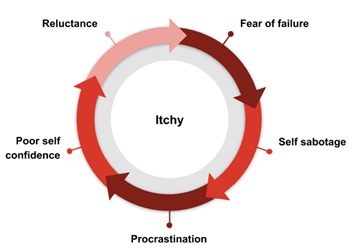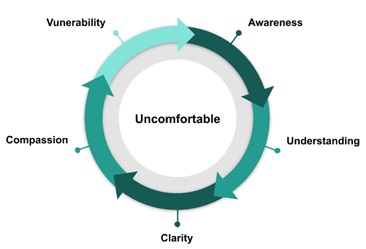 A Coaching Power Tool Created by Cheryl Ewing
A Coaching Power Tool Created by Cheryl Ewing
(Health and Wellness Coach, NETHERLANDS)
You have brains in your head. You have feet in your shoes. You can steer yourself any direction you choose. You’re on your own. And you know what you know. And YOU are the one who’ll decide where to go…― Dr. Seuss, Oh, the Places You’ll Go!
Itchy vs. Uncomfortable
It begins with the pounding of your heart as the blood courses through your body at a greater speed than before. You become increasingly aware of the beat of your heart through your clothes, the flush of red warmth that spreads through your body, and the slight sheen of sweat that layers your skin. Your breath becomes erratic, shallow even. Where has the air gone? It feels like the oxygen is being sucked from the very air that you breathe. You gulp at the air in a relentless attempt to fill your lungs, to calm the racing heart, and to avoid the feeling of faintness that threatens. When did gravity get so heavy? Your body gives way to the pull of the earth and the weight of your thoughts. You battle to concentrate and form clear, coherent thoughts. Forget the racing of your heart, it is the racing of your mind that sends shivers of fear through the shaky existence of the present.
The confusion, the beating, the itchiness.
You sit in this place of itchiness because it is like greeting an old friend. You know it is safe and it will pass leaving you whole again. You understand this feeling and it comforts you. Even if deep down you know this feeling does not serve you, you are paralyzed in movement and thought. Stuck in your fear, stuck in your uncertainty, stuck in yourself. So you sit comfortably in this itchiness because the fear of the alternative is far worse. The alternative is not something you know, it is not something you have conquered and it is not something you are certain about.
You sit in this waiting place.. With the itch.
What is itchy?
I am afraid that sometimes you’ll play lonely games too. Games you can’t win ´cause you play against you
Itchy: an uneasy irritating sensation in the upper surface of the skin usually held to result from mild stimulation of pain receptors (1)
We are all too often faced with making a decision that is potentially challenging and uncomfortable. The tightrope walk between staying in the safe and known environment of what we understand or moving onwards towards the unknown and unchartered territory of where we want to be. It may be as simple as the decision of whether or not to have that uncomfortable conversation with your boss or to go on a vacation alone for the first time or whether to leave an abusive partner. Decisions always involve moving from where you are currently to where you want to be. Often the decision of indecision appears the safer option and we place significance and obstacles in the way to avoid confronting the task that frightens us. There are several reasons for this lack of direction during the phase of indecision.
It is quoted on several websites that 35 000 conscious decisions are made by one individual every day. That is roughly one every 2,5 seconds. Most of these decisions are relatively easy decisions in that the mind has been programmed over time to form mechanisms that streamline our thoughts and improve efficiency in committing to a single action. More complex decisions require a more explorative and complex approach using either intuitive or reasoned processes or a combination of the two. There are several challenges involved in the complex decision-making process. Uncertainty of the facts, the complexity of factors to consider, the consequences to each action, and interpersonal issues are just a few factors that may influence problem-solving and decision making. It is a delicate balance of weighing up each option, the positive and negative impact each option will potentially have, and aligning the decision with one’s true values and beliefs. All these challenges have the potential to lead to procrastination, avoidance, and indecision.
Deep within the complexity of problem-solving and decision making, lies our true value and belief system. The ability to align our choices to our truth with confidence and certainty. And herein, lies the itch. Values and beliefs are not always aligned with the truth. Values and beliefs are usually aligned with our perception of the truth which is coping strategies built up over our lifetimes and is how we understand, interpret, and regard certain circumstances. Perceptions become negative coping strategies to justify the action, decision, or situation and these maladaptive coping mechanisms are a person’s default setting in a time when we feel overwhelmed and insecure.
During this time of itchiness, we are paralyzed by our perception of our truths in a vain attempt to allow us a moment of tranquility and peace amongst the confusion and frustration of indecision. Fear of failure, self-sabotage, procrastination, poor self-confidence and reluctance are amongst the most common emotions encountered during the itch. These 5 core emotions of itchiness have one common underlying thread, the threat of shame. Shame is a painful emotion of conscious guilt or shortcoming. Shame attacks who we are as individuals rather than the actions and decisions we make. It is the essence of our ego, deep within unworthiness, discontent, and disconnect. Shame is the fundamental truth behind the itch of indecision and paralysis. Shame is greater than motivation and change.

What is uncomfortable?
Somehow you’ll escape all that waiting and staying. You will find the right places where the boom bands are playing
Uncomfortable: The feeling of unease or awkwardness; the feeling of slight pain or discomfort (1)
The transformation of itchiness into uncomfortable arises when we acknowledge our true beliefs and values and attach trust to the process of growth. Being uncomfortable is the courageous exploration of true self-awareness, self-reflection, and hope through compassion and forgiveness. Within this explorative discomfort, we relinquish ourselves from the heavy cloak of shame and dress lightly with vulnerability, curiosity, and optimism and in doing so, we give ourselves purpose and motivation.
The evolution of vulnerability occurs when we face our unknown fears. The fear of the unknown is to fear without solid ground, control, and stability. This is an emotion that does not sit comfortably with the human brain. A brain is designed to manage fears by creating boundaries and limits that objectify fear into manageable constraints that we, as humans can comprehend. Freeing oneself from fear is like free falling. There are no limits and no boundaries. Possibilities are endless and the scope and magnitude of what we can achieve are limitless.
And so in this space of uncomfortable; awareness, compassion, and vulnerability bring clarity and understanding. The foundations of human growth and exploration of one’s true self. The knowingness of our own existence.

Coaching application
And when you’re in a slump, you are not in for much fun. Un-slumping yourself is not easily done
When clients are paralyzed in itch and fear moving towards the uncomfortable realm of the unknown, coaching is a powerful tool in creating clarity and awareness. Powerful questions in coaching allow clients to explore their shame and vulnerability and create an emotionally and mentally supportive environment of progression and motivation.
There are 3 key areas that a coach can delve into to assist the client in transition.
- Questioning the itch
- Challenging the fear of the uncomfortable
- Making it manageable
Questioning the itch
It is helpful to allow the client to explore the current position they find themselves in, the reasons for that position, and the benefit of staying stuck. Seeking out the limiting values and beliefs of the client can open up areas of awareness leading to a re-evaluation of the effectiveness of their current position.
Challenging the fear of the uncomfortable
By questioning the client about the fears around a new action, the coach can help ground the client’s fears into a more realistic perspective of what is real vs what is not.
Making it manageable
Once the client is ready to move on, it is important to establish an action plan to cement the new awareness and perspective. Often breaking the task down into smaller, actionable steps help with motivating the client.
Reflections
¨ So be sure when you step. Step with great care and great tact and remember that Lifes a Great Balancing Act. Just never forget to be dexterous and deft.
And never mix up your right foot with your left.¨
I spent many agonizing hours going over possible words to describe the deep sense of discomfort I get when I am paralyzed in inaction and shame and then once moving into action, the unsettling feeling of exploring the unknown. The very description of itchiness at the beginning of the text is a physical response I have every time I need to experience something new and challenging. Over the last two years, itchy and I am like family. I tend to sit deep in my limiting beliefs until the roar of discomfort forces me into action. I don’t like the uncomfortable feeling of doing something unknown either but deep down within my gut; I know that I have achieved everything I have set my mind to so far and I have done it with strength, compassion, and immeasurable resolve. My transition from itchy to uncomfortable comes quicker for me now. I have the insight to look Itchy straight in the eye, realize my worth and forge ahead.
As quoted by the great Dr. Suess:
And will you succeed? Yes, you will, indeed! (98 ¾ percent guaranteed)
Resources:
Suess, Dr. Oh The places you will go. New York, Random House Inc, 1990